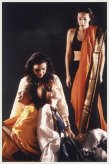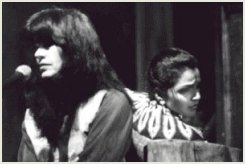 |
 |
 |
 |
 |
 |
 |
 |
|
Home | Collaborative Encounters | Workshops | Conferences Inner World From Ancient Tamil Poems of Love and War Credits Adapted for the stage by: MEENA NATARAJAN, Executive/Literary Director Pangea World Theatre, USA Directed by: DIPANKAR MUKHERJEE, Artistic Director, Pangea World Theatre, USA Choreographed by: ANITA RATNAM, Artistic Director, Arangham Dance Theatre, India "She": ANITA RATNAM "He": LEIGH GREGORY Chorus: SHARON CAGE, LUU PHAM, BARBARA RYAN, ANNA SOMMER Costume Designer: SONYA BERLOVITZ Set Designer: SEITU JONES Lighting Designer: SARAH SCHREIBER Composer/Musician: NIRMALA RAJASEKAR Musician: MAHESH CHIDAMBARA Synopsis MEENA NATARAJAN - Playwright's Statement: I first came across these Tamil poems about 12 years ago when I read A K Ramanujan's skillful translations of some of the anthologies of Tamil poetry. As I read these poems, I felt I was reading part of my own past. In the last few years, as I researched the poems and their backgrounds more thoroughly, I fell in love all over again with the clarity, subtlety and abandon of these poems, the richness of language that lingered on for days afterward, the ability to describe intense human experiences using rich metaphors with such economy of language that the images that were unlocked left me spellbound. The women in these poems gave in to passions and desires that were in strong contrast to later Indian poetry. Both the love and war poems grapple with the demands of society in contrast with human needs and yet provide no solutions, considering the questions of human existence with a profundity and complexity that is an inexhaustible source of insight and pleasure. Each poem was complete in itself, the challenge was to weave them together in a whole. One of my aims as I started this quest was to use poems from all eight anthologies. I have used poems from seven of them. The circle was complete when we met Anita Ratnam and began to talk about choreography married to narrative. As A K Ramanujan says, "One's own tradition is not one's birthright; it has to be earned, repossessed." I have loved every part of this journey and am deeply appreciative of the fact that I am one of the vehicles through which ancient words, full of wisdom and insight, can be seen 2000 years later. About the Translation: Tamil is the oldest of the main Dravidian languages in South India. It is an agglutinative language like Japanese, Finnish and Turkish and so forms its derivatives by a process of fusion. Suffixes are added to a verb or noun to inflect its meaning. Therefore in Tamil, verbs come at the end of the sentence, objects and adjectival clauses occur before predicates, adverbials before verbs; case-endings and particles occur after, rather than before, what they govern. This structure gives Tamil poetry a conciseness and terseness that is hard to reproduce in English. Also, as can be seen in the poem, Tamil does not pin down words as specifically as English. The result is that Tamil poetry is more conducive to the play of suggestion than English or Sanskrit poetry. Given the difference between Tamil and English, not every feature of one language can be imitated by another. We have crossed many boundaries in this re-telling, attempting to translate these wonderful translations into a script and finally to translate it again onto the stage embellished with movement and music. We can only hope that we have succeeded in opening a door to the symbolism and metaphor that is inherent in the greatest achievement of the Tamils – these poems. ANITA RATNAM - Choreographer's Note: Translation and transliteration are exciting challenges – in literature and in dance. As the soundscape of The Inner World moved from ancient Tamil to English, the choreography also embarked on a journey which, along the way, shed the enormous accumulation of detail and driving percussive rhythms of classical Indian dance. Instead, I revisited my tradition of dance and martial arts and began creating a framework where the spoken word and the moving body could be quilted into the fabric of the work. Syllables from Tamil folk-theatre, body stances from Yoga, postures from prayer and meditation flowed into the bodies of the cast whose individual cultural memories jostled with the intense passion and power of the spoken poetry. Originally created in India, the ancient mysteries of love and war arc across centuries with a timeless relevance – the choreography too has reflected my vision and artistic impulses, which is contemporary with echoes from an ancient source. NIRMALA RAJASEKAR - Composer's Note: "If music be the food of love, play on!" said the Immortal Bard. This is what I have aimed to do in this quest of The Inner World. The role of music in this creation is two-fold – it becomes the narrator sometimes and extrapolates on the emotions of the characters at other times. When I was invited to be part of this voyage, I wanted to try and make the music sound as though the verses were sung in the first century. I embarked on extensive research into the musicology of that period. My joy and amazement knew no bounds to find that some contemporary ragas (melodies) existed even then. They simply occurred under different names. The opening musical piece is a prologue to the play. It will present a gamut of emotions that you will hear in the play, including the falling in love of the heroine and hero, their elopement, war in the land and their reunion. Another feature of the music is the signature tunes for different people and emotions in the play. The heroine's character has a certain melody, which personifies her while the jeering society has quite a different temperament. Percussion has played a big part in war sequences with a powerful drumming which becomes very soft and gentle, heightening the mellow moments of reunion. Working in an atmosphere where there was constant creativity, for the play evolved as we were exploring, was a unique experience. I have enjoyed it very much indeed, and invite you to take this journey of artistic exploration with us. Critics Speak Her portrayal of a lover in torment utterly convinces; a subtly realised, indeed memorable performance ... fluid choreography and radiant visual tapestry. - Asian American Press ... blending of east and west, of classical and modern - fits right in with the poetry. - Star Tribune ... the actors convey meaning through the marriage of movement to language. - City Pages 
   |